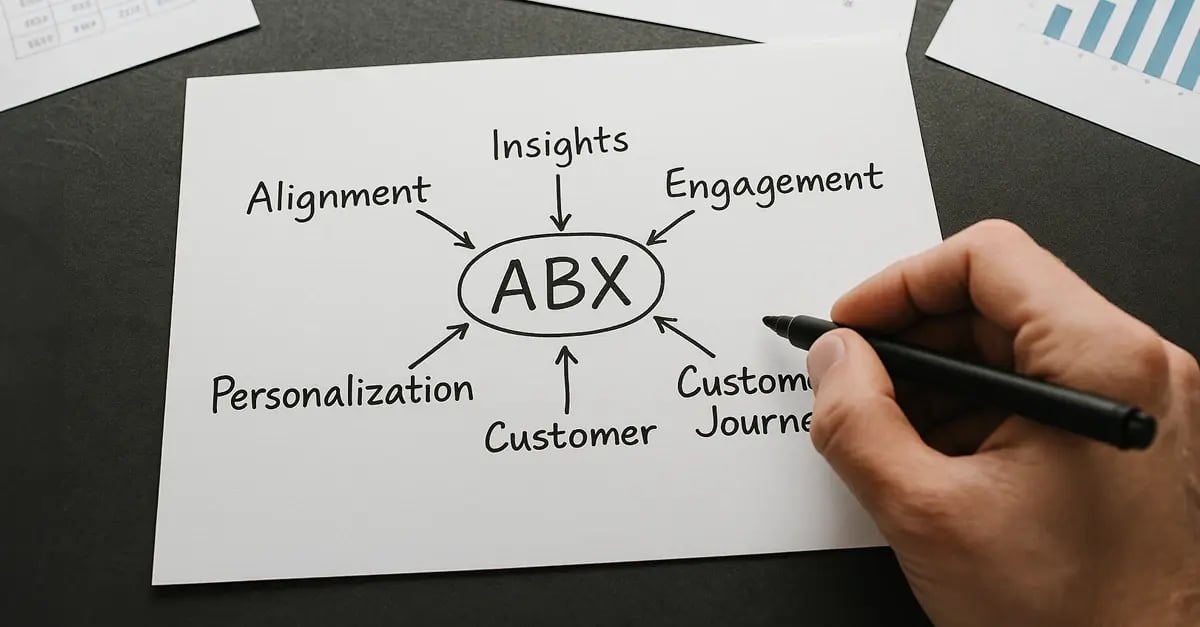In the constantly changing world of B2B marketing, traditional strategies such as Account-Based Marketing (ABM) are evolving into more advanced methods. One such approach is Account-Based Experience (ABX), which is a comprehensive strategy that not only targets high-value accounts but also emphasizes providing personalized experiences throughout the entire buyer journey. In this article, we will explore the meaning and examples of ABX, discuss its significance, and guide you on how to start implementing an effective ABX strategy.
What is Account-Based Experience (ABX)?
Account-Based Experience (ABX) is a sophisticated go-to-market strategy that combines marketing, sales, and customer success efforts to deliver a cohesive and personalized experience for targeted accounts throughout their entire lifecycle.
Unlike traditional marketing methods that aim for a broad audience, ABX focuses specifically on high-value accounts, customizing interactions and engagements to address their unique needs and preferences.
The core of ABX
At its core, the Account-Based Experience (ABX) combines the precision of Account-Based Marketing (ABM) with the personalization and engagement of modern customer experience (CX) strategies. It leverages data and insights to orchestrate relevant and trusted marketing and sales actions, ensuring that every touchpoint with the account is meaningful and contributes to building a long-term relationship.
ABX Meaning: Understanding the Terminology
To grasp the meaning of ABX, it’s important to break down its components:- Account-Based: This approach focuses on targeting specific accounts instead of individual leads.
- Experience: ABX emphasizes delivering a seamless and personalized journey for each account throughout all stages, from initial awareness to post-sale engagement.
In essence, ABX shifts the focus from simply generating leads to cultivating deeper, more meaningful relationships with key accounts.
Use case: Learn more about how companies utilize Account-Based Experience (ABX) strategies by clicking here.
Key Differences between ABX and ABM
While ABX and ABM share similarities, they differ in scope and execution:
- Focus
ABX: Delivering personalized and cohesive experiences across all interactions with target accounts.
ABM: Targeting and engaging high-value accounts through tailored marketing campaigns. - Scope
ABX: Integrates marketing, sales, and customer success for a holistic approach.
ABM: Primarily marketing-driven with some collaboration from sales. - Objective
ABX: Building long-term relationships and ensuring customer satisfaction and retention.
ABM: Acquiring and engaging accounts to move them through the sales funnel.
Visualize the Difference: Think of ABM as creating a tailored campaign for a select group of accounts, while ABX is about coordinating all interactions those accounts have with your brand, ensuring harmony and consistency at every stage.
Why ABX Matters in Modern B2B Marketing?
In today's competitive B2B landscape, delivering exceptional customer experiences is crucial. Here’s why account-based experience (ABX) is important:
- Enhanced Customer Relationships
ABX fosters deeper connections with target accounts by addressing their specific needs and preferences. This leads to increased loyalty and advocacy. - Improved Alignment Between Teams
By unifying marketing, sales, and customer success efforts, ABX ensures that all teams are working towards common goals, enhancing overall efficiency and effectiveness. - Higher ROI
Focusing resources on high-value accounts and delivering personalized experiences typically results in better conversion rates and higher returns on investment compared to traditional broad-based marketing strategies. - Adaptability to Buyer Behavior
Modern B2B buyers are well-informed and expect personalized interactions. ABX meets these expectations by providing relevant and timely engagements throughout the buyer's journey.
Key Benefits of Implementing ABX
Implementing an ABX strategy offers numerous advantages:- Increased Revenue Growth: Personalized experiences can drive higher sales and better upsell opportunities.
- Better Customer Retention: Engaged and satisfied accounts are more likely to remain loyal and continue purchasing.
- Enhanced Brand Perception: Delivering consistent and relevant experiences builds trust and positions your brand as a reliable partner.
- Efficient Resource Allocation: By targeting specific accounts, you can allocate marketing and sales resources more effectively, focusing on those with the highest potential.

How to Implement ABX: Strategies and Best Practices
- Identify and Select Target Accounts
Begin by defining your ideal customer profiles (ICPs) and selecting high-value accounts that align with these profiles. Use data-driven insights to identify accounts that present the greatest potential for growth and revenue. - Gather Comprehensive Account Intelligence
Leverage data and analytics to understand the needs, pain points, and preferences of your target accounts. This includes:
- Demographic and Firmographic Data: Information about the company’s size, industry, location, and structure.
- Behavioural Data: Insights into how the account interacts with your brand, including website visits, content downloads, and event attendance.
- Intent Data: Signals indicating the account’s interest in your products or services, based on their online behavior. - Create Personalized Content and Messaging
Develop content tailored to the specific needs and interests of each target account. This can include:
- Customized Email Campaigns: Personalized messages that address the account’s unique challenges.
- Industry-Specific Case Studies: Demonstrations of how your solutions have benefited similar companies.
- Personalized Web Experiences: Dynamic website content that adjusts based on the account’s profile and behavior. - Align Marketing, Sales, and Customer Success Teams
Ensure seamless collaboration among all departments involved in the Account-Based Experience (ABX) strategy. This involves:
- Regular Communication: Hold cross-functional meetings to share insights and updates on target accounts.
- Shared Goals and Metrics: Define common objectives and key performance indicators (KPIs) to measure the success of ABX initiatives.
- Integrated Systems and Tools Use platforms that facilitate data sharing and collaboration among teams. - Engage Through Multiple Channels
Reach out to target accounts through various channels to maximize visibility and engagement. These channels may include:
- Email Marketing: Personalized and targeted email campaigns.
- Social Media: Engaging with accounts on platforms like LinkedIn.
- Direct Mail: Sending personalized packages or gifts.
- Webinars and Events: Hosting events tailored to the interests of your target accounts. - Nurture and Maintain Relationships
Building long-term relationships requires ongoing engagement and support. Implement strategies such as:
- Regular Check-Ins: Touch base with accounts to understand their evolving needs.
- Exclusive Content and Offers: Provide loyal accounts with special benefits or early access to new products.
- Feedback Mechanisms: Solicit feedback to continuously improve your offerings and approach.
Examples of Successfull ABX Strategy Implementation
Example 1: FinTech Company Y – Elevating Enterprise Sales
Challenge:
Company Y, a global fintech firm, faced difficulties converting large enterprise leads due to generic messaging and disconnected marketing and sales efforts.
Solution:
They adopted an ABX strategy that combined targeted advertising, personalized email nurturing, and coordinated outreach between marketing and sales teams. Each campaign was tailored to industry-specific pain points.
Results:
- 42% Increase in Enterprise Conversions
- 60% Boost in Sales Qualified Leads (SQLs)
- 20% Faster Deal Cycles
Example 2: Healthcare Tech Firm Z – Boosting Retention and Expansion
Challenge:
Firm Z had trouble expanding within existing accounts and noticed low retention rates from their healthcare clients.
Solution:
They implemented ABX by segmenting key accounts by type (e.g., private clinics, hospitals) and creating bespoke educational content, onboarding programs, and check-ins based on account stage and needs.
Results:
- 30% Growth in Account Expansion Revenue
- 18% Increase in Customer Retention
- 25% More Engagement on Nurture Content
Example 3: SaaS Company W – Breaking into New Markets
Challenge:
SaaS Company W wanted to break into a new market segment but struggled with brand recognition and low engagement.
Solution:
Using ABX, they developed highly personalized campaigns targeting only their Ideal Customer Profiles (ICPs) in the new market. They used enriched firmographic data to tailor messaging and deployed real-time intent data to time outreach perfectly.
Results:
- 50% Increase in Demo Bookings
- 22% Higher Email Open Rates
- 3x ROI Compared to Previous Broad Campaigns
Best Practices for a Successful ABX Strategy
To ensure your ABX initiatives yield the desired outcomes, adhere to the following best practices:
- Deeply Understand Your Target Accounts
Invest time in researching and comprehending the specific challenges and goals of each target account. This understanding forms the foundation of personalized and effective engagements. - Foster Cross-Departmental Collaboration
Ensure that marketing, sales, and customer success teams work in tandem, sharing insights and aligning strategies to provide a cohesive experience for target accounts. - Leverage Data and Analytics
Utilize comprehensive data to inform your strategies, enabling you to make informed decisions and continuously refine your approach based on actionable insights. - Personalize Every Interaction
From the first touchpoint to post-sale support, ensure that every interaction is tailored to the account's preferences and needs, enhancing relevance and engagement. - Continuously Optimize Your Strategy
Regularly assess the performance of your ABX initiatives, using feedback and data to make necessary adjustments and improvements. - Invest in the Right Tools
Equip your teams with the necessary tools and technologies that facilitate data management, automation, and seamless collaboration, thereby enhancing the efficiency of your ABX strategy.
Common Challenges in Implementing ABX and How to Overcome Them
- Alignment Between Teams
Challenge: Siloed departments can hinder the cohesive execution of ABX strategies.
Solution: Foster a culture of collaboration through regular communication, shared goals, and integrated platforms that facilitate data sharing. - Data Quality and Integration
Challenge: Inaccurate or fragmented data can undermine the effectiveness of ABX initiatives.
Solution: Invest in robust data management systems and ensure seamless integration between different data sources to maintain accuracy and comprehensiveness. - Scalability
Challenge: Scaling ABX efforts across numerous accounts can be resource-intensive.
Solution: Utilize automation tools and prioritize high-value accounts to efficiently manage and scale your ABX strategy without compromising quality. - Measuring Effectiveness
Challenge: Determining the ROI of ABX strategies can be complex.
Solution: Define clear KPIs and employ analytics tools to track and measure the impact of your ABX initiatives, enabling data-driven decision-making.
The Future of ABX: Trends to Watch
As B2B marketing continues to evolve, ABX is poised to play an increasingly pivotal role. Here are some emerging trends:
- Artificial Intelligence and Machine Learning
AI-powered tools can enhance ABX strategies by providing deeper insights, automating personalized interactions, and predicting account behaviors. - Greater Integration of Customer Success
Integrating customer success more deeply into ABX ensures that accounts continue to receive value post-sale, fostering long-term relationships and advocacy. - Enhanced Personalization Techniques
Advancements in personalization will enable even more tailored experiences, addressing the specific nuances and preferences of each target account. - Omnichannel Engagement
Delivering a seamless experience across multiple channels—digital and physical—will become increasingly important in meeting the evolving expectations of B2B buyers.
Conclusions
Account-Based Experience (ABX) represents the next frontier in B2B marketing, offering a holistic and personalized approach to engaging high-value accounts. By integrating marketing, sales, and customer success efforts, ABX not only drives higher conversion rates and revenue growth but also fosters lasting relationships built on trust and relevance.
As businesses navigate the complexities of modern B2B markets, adopting an ABX strategy can provide a significant competitive edge, ensuring that every interaction with target accounts is meaningful and impactful.
Embrace the ABX meaning and transform your go-to-market approach to achieve sustained success in the dynamic world of B2B marketing.






Comments